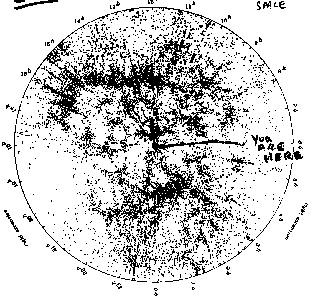 Large-Scale Structure
Large-Scale Structure
 Large-Scale Structure
Large-Scale Structure
A second goal of DEEP is to chart the distribution of galaxies in space at high redshifts. As above, DEEP's probe of the distant universe can be compared to nearby data to study the time-evolution of galaxy clustering (see Figure 2).

Figure 2: CfA redshift survey.
Consider a strawman universe dominated by cold-dark matter and with Omega = 1. At z=0.5 in such a universe, the mass scale for clustering is only half its present value. Thus, if the clustering is evolving under gravity, we expect the size of structures just forming to be significantly less massive in the past. This prediction must be used cautiously, however, because galaxies might not be good tracers of the mass, i.e., they might be biased. Furthermore, different types of galaxies might be clustered differently. Although evidence for bias in galaxy correlations is weak today (Alimi et al 1989 AA 206, L11), at higher redshifts, more massive objects might be more clustered (White et al 1987 Nature 330, 451). If instead galaxies faithfully trace the matter, the Universe must be open, and the correlation strength should be approximately constant in physical units for all types of galaxies on small scales but constant in comoving units on large scales. The point is simply that different models predict a variety of different effects that should be well within the possibility of measurement.
Home |
Overview |
Current Research |
Publications |
Archive
Personnel |
Funding & Sponsors |
Observational Resources